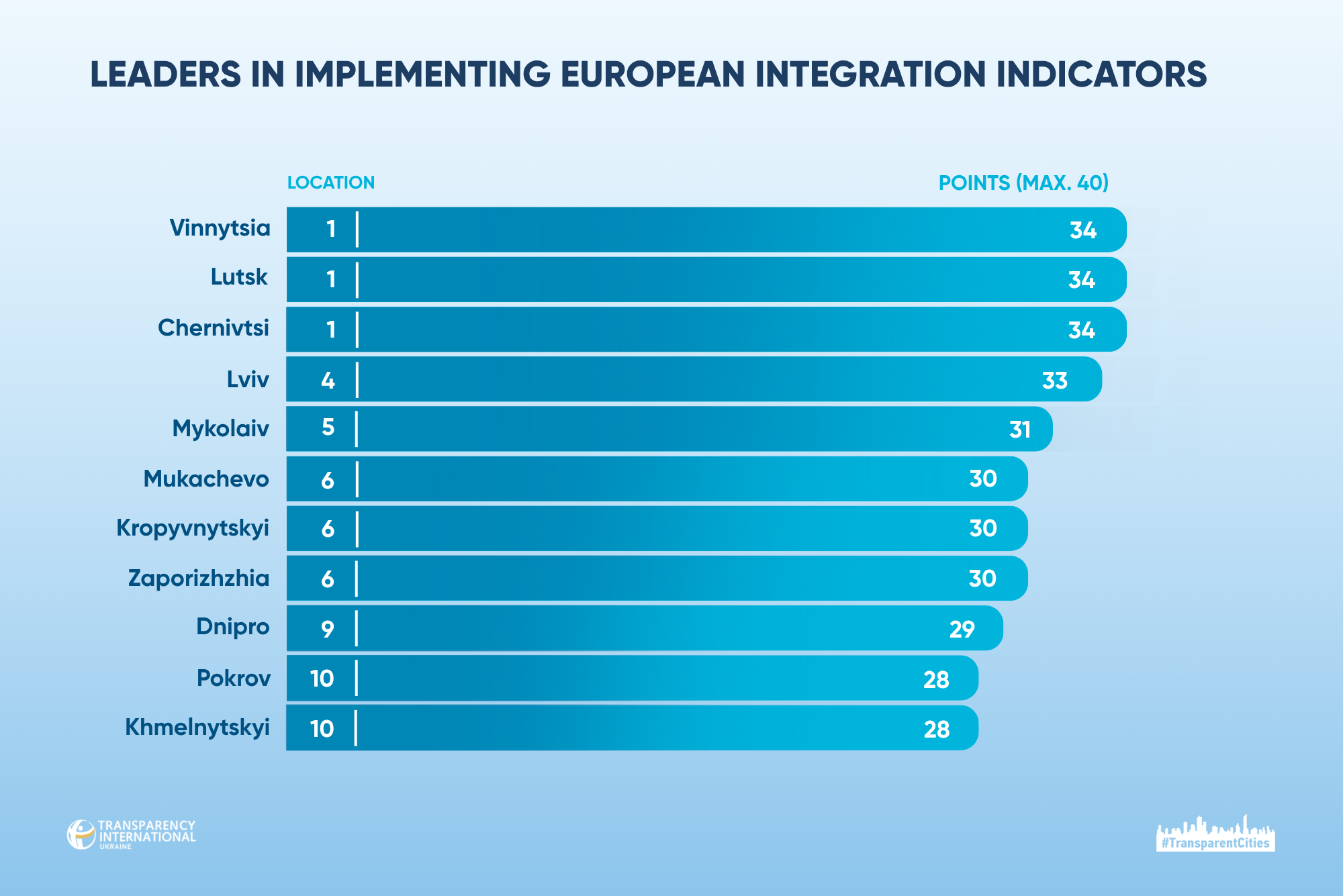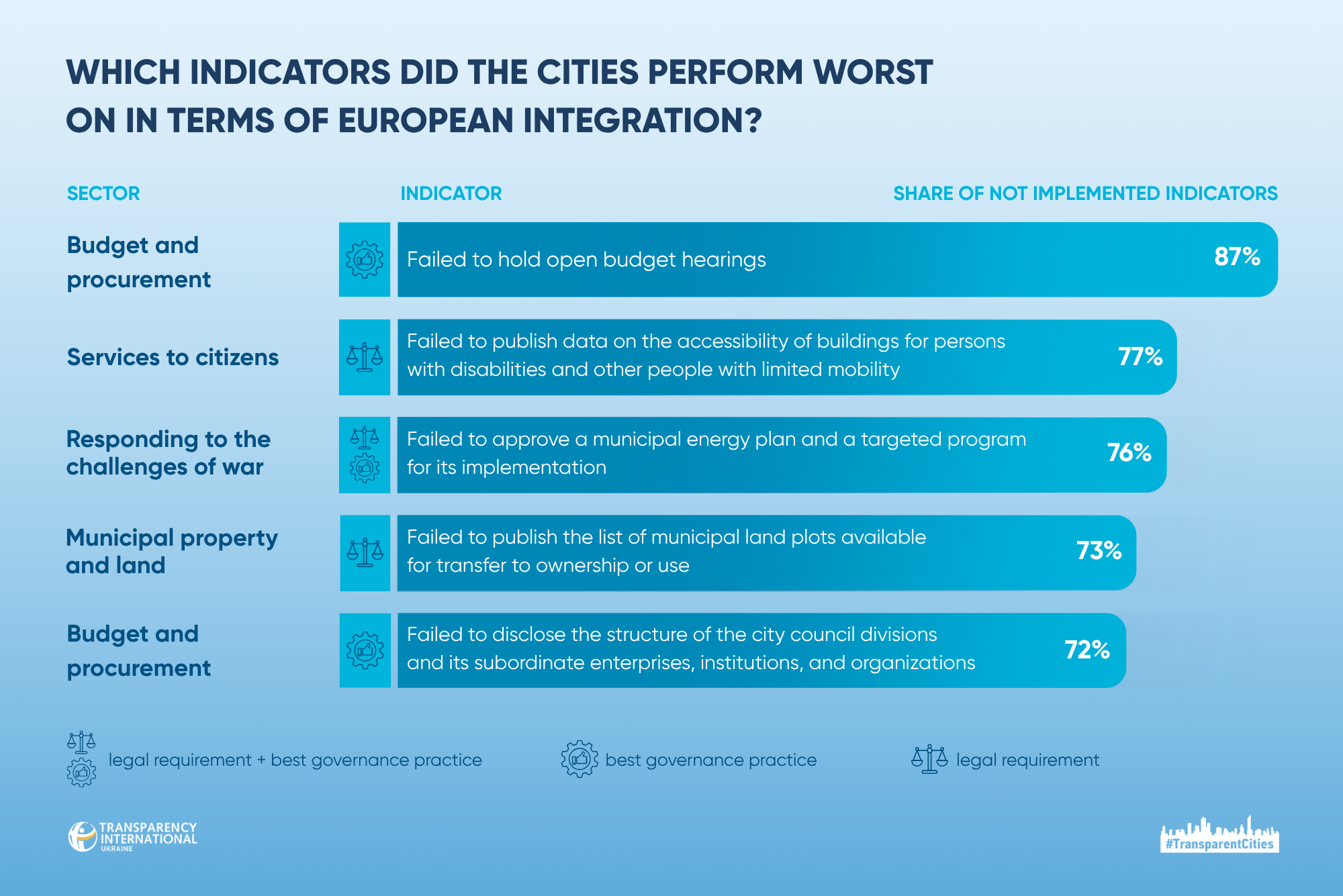Ukraine’s European integration should progress not only through legislation at the national level, but also through changes at the local level. To assess how closely Ukrainian cities align with European standards, we analyzed 31 out of 70 criteria from the Transparent Cities program’s City Transparency Ranking. These specific indicators correspond to the EU Facility Plan requirements and the European Commission’s 2024 enlargement report recommendations. Read our analysis to see how Ukrainian cities contributed to European integration in 2024.
The Transparent Cities program of Transparency International Ukraine examined performance of 100 municipalities from January to December 2024. The evaluation was based on 70 indicators, with a maximum possible score of 100 points. To receive transparent status, a city needed at least 75 points; for partially transparent status, 50 points or more. The evaluation criteria were developed based on both legal requirements and prevalent governance practices, drawn from previous research and analysis of European experience. This year, the methodology also included alternative indicators for cities that could not meet certain core criteria—for example, in cases where no infrastructure had been damaged or destroyed.
Analysts reviewed official and specialized websites of city councils, as well as those of their departments, divisions, and subordinate enterprises, and examined responses to information requests. They also analyzed data from the BI Prozorro public analytics module, the Prozorro.Sale electronic trading system, and the Unified State Open Data Web Portal. In the 2024 Ranking, the indicators were grouped into seven areas of municipal governance: openness, budget and procurement, municipal property and land, public relations, HR policy and integrity, services to citizens, and response to war-related challenges.
Every area of the study includes European indicators, which make up 44% of all criteria. These indicators assess whether municipalities meet the requirements of the EU Facility Plan and the European Commission’s enlargement report. They cover publishing decisions, minutes, and broadcasts of city council and its agencies’ meetings; holding open budget hearings and other public consultations; establishing an internal control and audit agency; developing a local anti-corruption tool; publishing data on the accessibility of buildings for people with disabilities; and ensuring transparency in reconstruction through the DREAM platform, among other sectors.
*Since four of the European integration indicators were evaluated only in some cities, the scores were calculated based on the 27 indicators that were assessed in all cities.
All five transparent cities and six partially transparent ones became leaders in meeting European integration requirements. Vinnytsia, Lutsk, and Chernivtsi share the first place—each earning 34 out of 40 possible points. These three cities also topped the 2024 Transparency Ranking. Eight of the top ten are large cities, but strong results were also shown by the mid-sized city of Mukachevo (population 50,000–200,000) and the small city of Pokrov (under 50,000), which scored the same as the regional center Khmelnytskyi. Two cities located in regions classified as potential hostility areas—Mykolaiv and Zaporizhzhia—also delivered strong results, earning 31 and 30 points, respectively, on the European integration criteria.
Best European Integration Practices Among Cities
Lutsk stands out for fully meeting all indicators in the area of HR policy and integrity. The city also demonstrates strong performance in openness and public relations. One of its key achievements was the development and implementation of the Anti-Corruption Program for 2024–2026. To this end, Lutsk created a dedicated working group and held public consultations. All related documents—the minutes, the full program text, and the 2024 progress report—are available on the city website. This approach reflects the priorities outlined in the European Commission’s report (Section 2.4), which highlights the need to strengthen integrity, including through sectoral or local anti-corruption strategies based on risk assessments.
Vinnytsia is also consistently implementing transparent practices. For example, its anti-corruption action plan helps raise awareness among city council staff on issues of transparency and accountability. In 2024, the Vinnytsia City Council reported on training sessions it conducted—covering topics such as electronic declarations and recent changes in anti-corruption legislation. According to the EU Facility Plan, the capacity of public administration is critical for implementing the Plan. Systematic training of personnel on integrity, asset declaration, and anti-corruption law is a key tool for building lasting capacity at the local level.
Pokrov, with a population of just 34,000 (based on mobile operator data) and a budget of UAH 536 million, emerged as a leader primarily due to its high level of city council openness and its effective response to war-related challenges. One notable achievement is the municipal energy plan for 2024–2026, adopted by fewer than a quarter of the cities studied. This plan is especially important for Ukraine’s European integration, particularly in the context of the negotiation cluster Green Energy and Sustainable Development. Having a municipal plan that addresses wartime challenges supports the city’s energy security and improves its capacity to provide residents with energy and utility services.
Mykolaiv also fully met the European criteria in the area of openness and was one of nine cities to properly publish, on its official website, the structure of city council departments, indicating the subordination of enterprises, institutions, and organizations, along with their Unified State Register of Enterprises and Organizations of Ukraine (USREOU) codes. This level of detail helps citizens and businesses better understand how local government functions and reinforces the accountability of local authorities.
Finally, another city classified as a potential hostility area that ranked among the leaders in the European integration assessment is Zaporizhzhia. Like Pokrov and Mykolaiv, the city showed its strongest results in the areas of openness and response to war-related challenges. The official city council website includes a dedicated section with up-to-date information for entrepreneurs on operating a business under martial law. It brings together details on available support programs, grant opportunities, current taxes, and rates—all of which help small and medium-sized businesses navigate crisis conditions. This approach aligns with the reform directions outlined in the negotiation cluster Competitiveness and Inclusive Growth, particularly regarding business environment development. At the same time, transparent communication with the community about business opportunities meets the expectations of the EU Facility Plan (Section 3).
Challenges on the Path to European Integration
On average, cities fulfilled 46.7% of the European integration criteria—meaning a significant portion of the indicators remains either partially addressed or completely overlooked. Still, there are areas where we see progress. Most cities now use the DREAM system for accountable reconstruction management, publish government decisions, make public their Activity Plans for drafting regulatory acts, hold public hearings, discussions, or consultations, and share up-to-date information on doing business under martial law. You can find more detail on these indicators in the City Transparency Ranking 2024 policy brief.
At the same time, several other requirements remain a serious challenge for many municipalities.
The most problematic requirement for city councils has been holding budget hearings. In most cities, this practice is either absent or implemented superficially—only six cities implemented it fully. Both the Ukraine Facility Plan (Sections 2 and 9) and the European Commission’s report (under the Democracy and Public Administration Reform section) emphasize that citizen participation in decision-making and transparency in the budget process are essential conditions for the country’s sustainable recovery. It is budget hearings specifically—where all public recommendations must be formally considered at a city council session—rather than consultations or discussions (which most municipalities typically hold), that serve as one of the most effective mechanisms for public influence over budget allocation.
Citizen participation in local governance is impossible without a clear understanding of who makes decisions and manages budget funds. Transparency in this area is a necessary precondition for responsible governance. Residents should clearly know the structure of the local self-government body, which municipal enterprises and institutions report to whom, who receives funding, and who is accountable for implementing specific projects. The fact that only nine cities have fully published the structure of their city councils and subordinate organizations indicates an unwillingness to involve the public, media, civil society, or businesses in decision-making processes.
Information on the accessibility of buildings for people with disabilities is another requirement that most communities continue to overlook. Meanwhile, ensuring inclusive access is one of the key goals in the Ukraine Facility Plan (Section 7.2) and a priority in the European Commission’s report (Chapter 23). With the number of people with disabilities rising—among both civilians and veterans—public policy, including local strategies, must guarantee real inclusion and access to infrastructure.
In addition, the Transparent Cities program assessed whether information on building accessibility was available in open data format—that is, machine-readable and published both on the websites of local self-government bodies and on the National Open Data Web Portal. The European Commission’s report (Section 18) emphasizes the importance of data and statistics, as well as the administrative capacity of authorities to provide them. Another indicator that falls under these requirements—but was, unfortunately, poorly implemented by Ukrainian cities—is the publication of a list of municipal land plots available for transfer into private ownership.
European standards are not abstract principles—they are reflected in everyday governance decisions made at the local level. Many EU requirements are already embedded in the Transparency Ranking, and every city that adopts these practices not only improves its score but also directly contributes to bringing the country closer to EU membership.
The Transparent Cities program of Transparency International Ukraine recently presented the results of the City Transparency Ranking. In 2024, five cities were classified as transparent: for the first time since the full-scale invasion, Chernivtsi, Vinnytsia, and Lutsk made it into the top three, joined by 2023 leaders Mukachevo and Lviv. Twenty-two cities received the status of partially transparent, while the remaining 72 remained in the non-transparent category (We excluded Ternopil from the ranking). Kyiv was classified as partially transparent, scoring 51.5 points and placing 26th overall.
Transparency International Ukraine is an accredited representative of Global Transparency International. Since 2012, TI Ukraine has been helping Ukraine grow stronger. The organization takes a comprehensive approach to the development and implementation of changes for reduction of corruption levels in certain areas.
TI Ukraine launched the Transparent cities program in 2017. Its goal is to foster constructive and meaningful dialogue between citizens, local authorities, and the government to promote high quality municipal governance, urban development, and effective reconstruction. In 2017–2022, the program annually compiled the Transparency Ranking of the 100 largest cities in Ukraine. After the full-scale invasion, the program conducted two adapted assessments on the state of municipal transparency during wartime. In 2024, the program resumed the creation of the transparency ranking for the 100 largest cities in Ukraine.
Attention
The authors do not work for, consult to, own shares in or receive funding from any company or organization that would benefit from this article, and have no relevant affiliations


